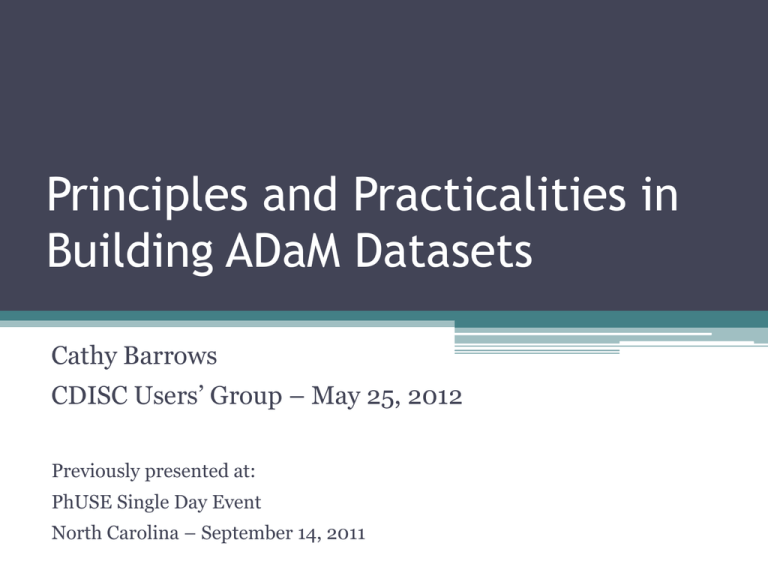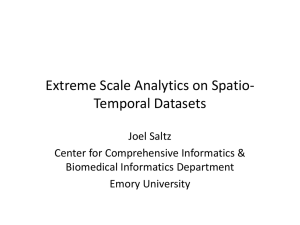
Principles and Practicalities in
Building ADaM Datasets
Cathy Barrows
CDISC Users’ Group – May 25, 2012
Previously presented at:
PhUSE Single Day Event
North Carolina – September 14, 2011
2
Goal:
• Present practical issues / points / considerations
in building ADaM datasets
• In the hopes that it will be helpful information
that will benefit you…
3
How?
• Set the stage - Where ADaM has been (a bit of
history)
• Where ADaM is now
• Learnings from the development of the ADaM
General Examples Document
▫ Provide an overview of the document
▫ Highlight issues encountered, questions we grappled
with, and some of the thinking behind the decisions
made
4
A bit of history…
and an analogy
5
Statistical Analysis Dataset Model:
General Considerations Version 1.0
(Final 2005)
• Key Principles for Analysis
Datasets
• Identified categories of
analysis variables, defined a
few specific variables:
▫ Analysis datasets should:
facilitate clear and unambiguous
communication
be useable by currently available
tools
be linked to machine-readable
metadata
•
be analysis-ready
▫
▫
▫
▫
--DT --DTM
ANLDY, which included Day 0
ANLDYT
TRTP, TRTPN, TRTA, TRTAN
Metadata
▫ Analysis Dataset Metadata
▫ Analysis Variable Metadata
▫ Analysis-level Metadata
6
“Appendix” Documents:
Categorical and Change from Baseline
(for comment 2005)
• Illustrated structure considered by ADaM team to be
most “analysis-ready”
• “However the use of a particular structure in the
example is not meant to imply that it is the
recommended format.”
• For example, change from baseline
gave 1 recommended +
2 alternative structures
7
Analysis Data Model: Version 2.0
(for comment 2006)
• More stringent requirements
• No or little change:
▫ Key Principles for Analysis for ADaM datasets:
▫ Analysis datasets must
Datasets
include ADSL
▫ Metadata
consist of the optimum number
• Added more ADaM variables
of analysis datasets
• Defined ADSL
maintain SDTM variable
attributes if the identical
variable also exists in an SDTM
dataset.
naming convention
“ADxxxxxx.”
consistently follow sponsordefined naming conventions for
datasets and variables
8
Where we are today • ADaM Model Document v2.1
▫
▫
▫
▫
Enumerates fundamental principles of ADaM
Introduces and defines Traceability
Outlines the various types of ADaM metadata
General considerations when creating analysis
datasets including ADSL and BDS
• ADaM IG v1.0
▫
▫
▫
▫
Standard variable naming conventions
ADSL variables
BDS variables
Implementation issues, standard solutions and
examples
Published in 2009
9
In the spirit of continuing to develop
the road that is ADaM…
10
Well along in development:
• Compliance checks
▫ Phase 1 available now
▫ Phase 2 under development
• ADAE
▫ Hopefully to be posted THIS WEEK!
• ADTTE
▫ Hopefully to be posted THIS WEEK!
11
In active development, but still early
• Metadata
▫ guidance and examples for representing metadata for ADaM
• General Occurrences
▫ expand ADAE model to cover similar analyses
▫ e.g. conmeds, med history, surgery
• Multiple Endpoints
▫ multivariate analyses
▫ analysis variables required to be on the same record
• ISS/ISE Integration
▫ guidance on standards for data integration
• ADPK
▫ guidance for creating PK analysis datasets
12
And we have the …
• General Examples Document
13
Analysis Data Model Examples in Commonly
Used Statistical Analysis Methods
• Full examples of applied ADaM implementation
▫ sample data, dataset metadata, results, and results level
metadata
▫ Based on ADaM Model Document V2.1 and ADaMIG V1.0
• Status:
▫ Published on the CDISC webpage in January 2012
14
Structure of the document
• Section 1 - Introduction
▫ Purpose
▫ Common statistical analysis methods
Mapping to the examples
▫ Points to consider when building analysis
datasets
ADaM concepts and principles applied in
example
▫ Conventions used in this document
Decisions made in developing the examples
▫ Caveats and disclaimers
15
Structure of the document
• Section 2 – Examples
• Structure of Examples:
▫ ANCOVA
▫ Introduction
▫ Categorical analysis
▫ Analysis Metadata
(dataset and variable)
▫ Repeated measures
▫ Descriptive statistics
▫ Logistic regression
▫ Multivariate ANOVA
▫ Crossover study
▫ Hy’s law
▫ Analysis dataset
illustration
▫ Analysis results (sample
and results metadata)
16
DID NOT:
• … implement or advocate new rules or standards
• … attempt to identify specific SDTM domains
▫ Focus is on analysis datasets not SDTM
• … attempt to include all possible variables
▫ Did try to include those that would be included
for the analysis being described
• … attempt to include all variables described in
the metadata in the dataset illustrations
17
Points to consider when building ADs
• Optimum number of analysis datasets
▫ Goal is to have the optimum number of analysis
datasets needed to perform the various analyses
▫ Examples provided of a single dataset that supports
multiple analyses (examples 1-4)
▫ Also note that the same analysis dataset can be used
to generate descriptive statistics such as the count and
percentages
18
Points to consider when building ADs
• Ordering of variables
▫ Authors of examples each used their own ordering - no
specific ordering of variables within the illustrated
datasets is applied (ADaM makes no specific
recommendation)
▫ Important to note that within an example the
ordering of the variables within the illustrated analysis
dataset matches the order of the variables as presented
in the associated metadata.
19
Points to consider when building ADs
• Identification of source dataset
▫ When identifying the source dataset for a variable, the
immediate predecessor is used, as described in the
ADaM, for example:
AGE in ADSL - source is identified as DM.AGE
AGE in other analysis datasets - source is identified as
ADSL.AGE
20
Points to consider when building ADs
• Parameter value-level metadata
▫ Parameter value-level metadata are included for BDS
analysis datasets
required in variable-level metadata for a BDS analysis dataset
(currently stated that way in the ADaM v2.1 document)
▫ ADSL – no parameter value-level metadata
▫ Note that parameter value-level metadata is NOT a
separately defined set of metadata
parameter identifier is “simply” an additional metadata
element
21
Points to consider when building ADs
• Analysis-ready
▫ Contain all of the variables needed for the specific
analysis
▫ No need for first manipulating data
▫ Only “simple” manipulations (i.e., “minimal
programming”), if any, to prepare for analysis
22
Analysis-ready – What is meant by
“minimal programming”?
• Select? – yes
• Sort? – yes
• Transpose? – no
▫ because of the variations in terms of the variable to be
transposed, how to define the new variable names,
what other fields should be included in the transposed
dataset, etc.
• Merge or Join? – sponsor decision
▫ difficult to draw the line as to which merges are
minimal and which are no longer minimal, so no
distinction made by ADaM
23
Not intended to imply a
requirement or standard!
24
Parameter Identifier
• Only one PARAM/PARAMCD in the dataset… 3
options considered
▫ Parameter Identifier = *ALL* for all variables
▫ Parameter Identifier = the PARAMCD for all
variables
▫ Combination:
Parameter Identifier = the PARAMCD for variables that
have metadata dependent on the analysis parameter
Parameter Identifier = *ALL* for variables expected to
be consistent across analysis parameters
Allows concatenation of analysis datasets without
having to re-do the metadata
25
Illustration of Parameter Identifier:
Parameter
Identifier
PARAMCD
Variable Variable
Name
Label
PARAMCD Parameter
Code
Variable Display Codelist /
Type
Format Controlled Terms
text
$8
BMDLS
*ALL*
AVISIT
Analysis
Visit
text
$11
BMDLS
AVAL
Analysis
Value
float
8.1
BASELINE,
MONTH 6,
MONTH 12,
MONTH 18,
MONTH 24,
MONTH 30,
MONTH 36,
Source / Derivation
Populated with ”BMDLS” for records
corresponding to Lumbar Spine Bone
Mineral Density (based on
XX.XXTESTCD)
Refer to Section X.X of the SAP for a
detailed description of the windowing
and imputation algorithms used to
determine the analysis visit based on
ADBMD.ADY
AVAL = XX.XXSTRESN or an imputed
value
if XX.XXSTRESN is missing, apply the
LOCF algorithm, i.e. set AVAL equal to
the value for the previous post-baseline
time point (AVISIT). If the previous
timepoint is baseline, leave AVAL
missing
26
Parameter value-level metadata: use
of *ALL*, *DEFAULT* ?
• Many decisions about the metadata revolve around its
usefulness in the future – machine readable and
executable
• Two camps regarding parameter value-level metadata
▫ 1) fully itemize so that every variable has metadata for every value
of PARAMCD
▫ 2) use *ALL* and *DEFAULT* to simplify entry for metadata that
does not change across PARAMCDs
• Important to understand that *ALL* and *DEFAULT*
are intended as short cuts – how you implement them
and/or display them in stylesheets is up to you
27
Illustrating two approaches to parameter
value-level metadata
Source / Derivation
Parameter Variable Variable Display Codelist /
Identifier
Name
Type Format Controlled
Terms
BIL
CRIT1FL text
$1
Y, N
ALT
CRIT1FL text
$1
Y, N
AST
CRIT1FL text
$1
Y, N
HYS1FL
CRIT1FL text
$1
HYS2FL
CRIT1FL text
$1
BIL
CRIT1FN integer 1.0
1=Y, 0=N
ALT
CRIT1FN integer 1.0
1=Y, 0=N
AST
CRIT1FN integer 1.0
1=Y, 0=N
HYS1FL
CRIT1FN integer 1.0
1=Y, 0=N
HYS2FL
CRIT1FN integer 1.0
1=Y, 0=N
“Y” if ADLBHY.AVAL>1.5*ADLBHY.ANRHIN, “N” otherwise
“Y” if ADLBHY.AVAL>1.5*ADLBHY.ANRHIN, “N” otherwise
“Y” if ADLBHY.AVAL>1.5*ADLBHY.ANRHIN, “N” otherwise
Blank if ADLBHY.PARAMTYP=”DERIVED”
Blank if ADLBHY.PARAMTYP=”DERIVED”
From ADLBHY.CRIT1FL
From ADLBHY.CRIT1FL
From ADLBHY.CRIT1FL
From ADLBHY.CRIT1FL
From ADLBHY.CRIT1FL
*DEFAULT*
BIL
ALT
AST
*ALL*
Blank if ADLBHY.PARAMTYP=”DERIVED”
“Y” if ADLBHY.AVAL>1.5*ADLBHY.ANRHIN, “N” otherwise
“Y” if ADLBHY.AVAL>1.5*ADLBHY.ANRHIN, “N” otherwise
“Y” if ADLBHY.AVAL>1.5*ADLBHY.ANRHIN, “N” otherwise
From ADLBHY.CRIT1FL
CRIT1FL
CRIT1FL
CRIT1FL
CRIT1FL
CRIT1FN
text
text
text
text
integer
$1
$1
$1
$1
1.0
Y, N
Y, N
Y, N
1=Y, 0=N
28
Parameter value-level metadata: use
of *ALL*, *DEFAULT* ?
• Metadata for PARAMCDs for which the variable is null?
▫ In this example, PARAMTYP=“DERIVED” for the HYS1FL
and HYS2FL parameters
Source / Derivation
Variable Display Codelist /
Type Format Controlled
Terms
float
7.3
ADLB.ANRHIN if
ANRHIN Analysis Normal
ADLBHY.PARAMTYP=” “,
Range Upper Limit (N)
1
blank otherwise
Parameter Variable
Identifier
Name
*ALL*
Variable Label
*DEFAULT* ANRHIN Analysis Normal
Range Upper Limit (N)
2
HYS1FL
ANRHIN Analysis Normal
Range Upper Limit (N)
HYS2FL
ANRHIN Analysis Normal
Range Upper Limit (N)
float
float
float
7.3
ADLB.ANRHIN
Not populated for records
with PARAMCD=”HYS1FL”
Not populated for records
with PARAMCD=”HYS2FL”
29
Codelist / Controlled Terminology
• Repeat the codelist metadata (whether it is a list
or a link to a list) every time variable is included
in a dataset, as in option 1 below?
Dataset
Name
Variable
Name
Variable Display
Type
Format
Codelist / Controlled Terms
ADSL
AGEGR1
text
$6
<25y, 25-50y, >50y
ADEFF
AGEGR1
text
$6
<25y, 25-50y, >50y
ADEFF
AGEGR1
text
$6
ADSL
RACE
text
$50
RACE
ADEFF
RACE
text
$50
RACE
ADEFF
RACE
text
$50
Source / Derivation
Derived from ADSL.AGE
1
2
ADSL.AGEGR1
ADSL.AGEGR1
DM.RACE
1
2
ADSL.RACE
ADSL.RACE
30
Codelist – include values that do not
appear in the dataset?
• Example:
▫ Males and females both eligible for study
▫ Only males enrolled
▫ Should SEX have codelist of “M,F” or “M”?
• Decision is to include all possible values
▫ because it could be important to know that value
was an option and not used (Example: severity
levels of AEs)
31
But what about the codelist for PARAMCD?
• For PARAMCD, only the values actually used in
the specified analysis dataset should be included
in the codelist within the variable metadata for
PARAMCD
• Similarly, there should be no value used as a
parameter identifier for that analysis dataset
that is not a PARAMCD within the dataset
32
Intentional blanks
• Result identifier:
▫ Can be left blank the results being described are not
just one specific portion of the display.
• Programming statements can be omitted :
▫ Can be left blank the information provided in the
other metadata elements is sufficient to describe the
analysis performed.
• How to indicate in metadata?
▫ <intentionally left blank>
▫ leave the metadata element empty
33
Illustration of <intentionally left blank>
Metadata Field
Metadata
DISPLAY IDENTIFIER
Summary E.2
DISPLAY NAME
Subjects with >3% Change from Baseline in Lumbar Spine Bone Mineral Density at Month 36 (ITT
Population, OC Data)
RESULT IDENTIFIER
<intentionally left blank>
PARAM
DXA BMD at Lumbar Spine (g/cm^2)
PARAMCD
BMDLS
ANALYSIS VARIABLE
CRIT1FL
REASON
Pre-specified in SAP
DATASET
ADBMD
SELECTION CRITERIA
ITTFL=“Y” and PARAMCD=“BMDLS” and AVISIT=“MONTH 36” and ANL01FL=“Y” and DTYPE=” “ and
PCHG not missing
DOCUMENTATION
See SAP Section XX for details.
Percentage in each treatment group of the number of subjects with non-missing percent change data at
Visit 8 (i.e., AVISIT=”MONTH 36”) who had >3% change in BMD from Baseline.
Subjects with missing change from baseline BMD data at Visit 8 are excluded from the analysis.
Number of subjects at MONTH 36 with CRIT1FL=“Y” divided by the number of subjects at MONTH 36
with non-missing PCHG. Fisher’s exact test used for treatment comparison.
PROGRAMMING
STATEMENTS
<Intentionally left blank>
34
Where is imputation defined – AVAL or
DTYPE?
• AVAL – include details of the imputation, since
is part of how to derive AVAL
• DTYPE – indicates whether or not the
imputation was performed for the record
35
Example of AVAL and DTYPE when
imputation is involved
Codelist /
Parameter Variable Variable Variable Display
Controlled
Identifier Name
Label
Type Format
Terms
BMDLS
BMDLS
AVAL
Analysis
Value
DTYPE Derivation
Type
float
8.1
text
$4
Source / Derivation
AVAL = XX.XXSTRESN or an
imputed value
if XX.XXSTRESN is missing, apply
the LOCF algorithm, i.e. set AVAL
equal to the value for the previous
post-baseline time point (AVISIT).
If the previous timepoint is
baseline, leave AVAL missing
LOCF
Populated with “LOCF” if
XX.XXSTRESN is missing, to
indicate that on that record
ADBMD.AVAL is populated using
Last Observation Carried Forward
method
36
Another example of AVAL and DTYPE
when imputation is involved
Codelist /
Variable
Controlled Source / Derivation
Name
Terms
AVAL
numeric version of XX.XXSTRESN or an imputed value
Imputation methods:
If there are non-missing data before and after the missing data, the missing
data will be imputed using linear interpolation taking time of the measurement
into account (“INTERPOL”: Linear interpolation)
If there are no observed data after the missing data and it is the first visit of a
period the missing data will be imputed using last observation carried forward.
(“LOCF”: Last observation carried forward)
DTYPE INTERPOL, Populated with imputation method used when the value of AVAL is imputed
LOCF
37
38
Analysis of Covariance and more
• Analysis dataset that supports multiple analyses:
▫ Analysis of covariance
▫ Categorical analysis
▫ Repeated measures
▫ Descriptive statistics
• Included are identification of baseline values,
change from baseline analysis, and handling of
missing data
Examples 1 - 4
39
Logistic regression analysis
• Analysis dataset that supports a logistic
regression including covariates
• Included is one way to use CRITy and CRITyFL
in supporting a categorical analysis.
Example 5
40
Multivariate Analysis of Variance
• Analysis dataset that supports
▫ estimation of treatment effect for multiple
variables (subscale scores) in the dataset
▫ an assessment of overall treatment effect (i.e., a
test of the main effect of study drug on the
combined subscales)
• Included are analysis results metadata for
specific items on a summary table
Example 6
41
Multivariate Analysis of Variance
• Illustrated analysis dataset is not analysis-ready
for the analysis of overall treatment effect
▫ a transpose of the dataset is needed
• Included are metadata to support the transpose
▫ Alternative: provide the transposed dataset as an
ADaM dataset that is not compliant with BDS but
fulfills the other requirements of an ADaM dataset
42
Metadata Field
DISPLAY NAME
RESULT IDENTIFIER
PARAMCD
ANALYSIS VARIABLE
DOCUMENTATION
PROGRAMMING
STATEMENTS
Metadata
Multivariate Analysis of Variance Testing the Hypothesis of No Overall Treatment Effect at
Week 6 (ITT Population)
Test for Overall Treatment Effect Considering All Subscales
ANXIETY, DPRESS, ANGER, VIGOR, FATIGUE, CONFUS
AVAL
Wilks’ Lambda multivariate test of treatment effect. See SAP Section XX for details.
Program: t-mood-effect.sas
The MANOVA statement in PROC GLM is used to generate the result after first transposing
ADMOOD. The six mood subscale scores are the dependent variables in the model, with
treatment being the only independent variable.
PROC TRANSPOSE DATA=ADMOOD OUT=ADMOODHZ;
VAR AVAL;
ID PARAMCD;
BY USUBJID TRTPN;
RUN;
PROC GLM DATA=ADMOODHZ;
CLASS TRTPN;
MODEL ANXIETY DPRESS ANGER VIGOR FATIGUE CONFUS = TRTPN /
NOUNI;
MANOVA H=TRTPN;
RUN;
Also note the multiple PARAMCDs…
43
Repeated Measures Analysis of a
Crossover Study
• Analysis datasets to support a crossover design
study using a mixed effect model
• Included are multiple baseline types, multiple
imputation methods, an analysis dataset created
from another analysis dataset
Example 7
44
Illustrates 3 analysis datasets
• ADSL
▫ the required subject-level analysis dataset
▫ illustrates how the treatment and period variables
are used for this study design
• ADFEV
▫ includes the individual responses that are
collected during the study and imputed records
• ADFEVAUC
▫ includes derived response data based on the
ADFEV dataset
• The producer of the datasets elected to not combine ADFEV and
ADFEVAUC into one dataset
45
Categorical Analysis of Subjects
Meeting Hy’s Law Criteria
• Analysis dataset that supports an analysis of lab
data based on Hy's Law criteria (liver function)
• Included are creation of new rows to contain
new analysis parameters, the use of PARAMTYP,
the use of the CRITy and SHIFTy variables
Example 8
46
Other interesting points to observe in
the document:
• Difference between DTYPE and PARAMTYP is
illustrated
• AVAL and AVALC do not both need to be
populated on each row - illustrated in Example 8
• Use of different contents in the same CRIT
variables as long as there is consistency within a
parameter – illustrated in Example 8
47
Other interesting points to observe in
the document:
• Variable types used in the document are those from CRTDDS
• No “Core” column
▫ The column is in the ADaMIG as part of defining variables
- it is not a metadata element
• Multiple hyperlinks are indicated in the examples
▫ The ability to include hyperlinks will be driven by the
software that the sponsor uses for submissions
• The presentation formats used in this document for
metadata are for the purposes of illustration of content only
48








